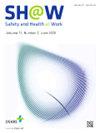Global Estimates on Biological Risks at Work
IF 3.5
3区 医学
Q1 PUBLIC, ENVIRONMENTAL & OCCUPATIONAL HEALTH
引用次数: 0
Abstract
Introduction
Biological risks are a major global problem in the workplace. The recent COVID-19 pandemic has highlighted the need for a more comprehensive understanding of the biological risks at work. This study presents data on both communicable infectious biological agents and noncommunicable factors leading to death and disability for the year 2021.
Methods
We followed the methodology established by the International Labour Organization (ILO) in their past global estimates on occupational accidents and work-related diseases. We used relevant ILO estimates for hazardous substances and related population attributable fractions derived from literature, which were then applied to World Health Organization mortality data. The communicable diseases included in the estimates were tuberculosis, pneumococcal diseases, malaria, diarrheal diseases, other infectious diseases, neglected tropical diseases, influenza associated respiratory diseases and COVID-19. Noncommunicable diseases and injuries considered were Chronic Obstructive Diseases (COPD) due to organic dusts, asthma, allergic reactions and risks related to animal contact. We estimated death attributable to biological risk at work and disability in terms of disability adjusted life years (DALYs).
Results
We estimated that in 2022, 550,819 deaths were caused by biological risk factors, with 476,000 deaths attributed to communicable infectious diseases and 74,000 deaths caused by noncommunicable factors. Among these, there were 223,650 deaths attributed to COVID-19 at work. We calculated the rate of 584 DALYs per 100,000 workers, representing an 11% increase from the previous estimate of the global burden of work-related disabilities measured by DALYs.
Conclusion
This is a first update since previous 2007 ILO estimates, which has now increased by 74% and covers most biological risks factors. However, it is important to note that there may be other diseases and deaths are missing from the data, which need to be included when new information becomes available. It is also worth mentioning that while deaths caused by major communicable diseases including COVID-19 are relatively rare within the working population, absences from work due to these diseases are likely to be very common within the active workforce.
工作中的生物风险全球估计
生物风险是工作场所的一个主要全球性问题。最近的COVID-19大流行突出表明,有必要更全面地了解工作中的生物风险。本研究提供了2021年关于传染性生物制剂和导致死亡和残疾的非传染性因素的数据。方法我们采用了国际劳工组织(ILO)在过去对职业事故和与工作有关的疾病进行全球估计时确定的方法。我们使用了国际劳工组织对有害物质和相关人群归因分数的相关估计,然后将其应用于世界卫生组织的死亡率数据。估计数中包括的传染病是结核病、肺炎球菌病、疟疾、腹泻病、其他传染病、被忽视的热带病、与流感相关的呼吸道疾病和COVID-19。考虑的非传染性疾病和伤害包括由有机粉尘引起的慢性阻塞性疾病(COPD)、哮喘、过敏反应和与动物接触有关的风险。我们根据残疾调整生命年(DALYs)估计了可归因于工作生物风险和残疾的死亡。结果我们估计,2022年,550,819例死亡是由生物风险因素造成的,其中476,000例死亡归因于传染性传染病,74,000例死亡归因于非传染性因素。其中,有223650人死于COVID-19。我们计算出每10万名工人中有584名伤残人员,这比之前用伤残人员年衡量的全球工伤残疾负担的估计增加了11%。这是自2007年国际劳工组织上一次估计以来的首次更新,上一次估计现在增加了74%,涵盖了大多数生物风险因素。然而,必须指出的是,数据中可能遗漏了其他疾病和死亡,需要在获得新信息时将其列入。还值得一提的是,虽然包括COVID-19在内的主要传染病造成的死亡在劳动人口中相对罕见,但在活跃劳动力中,由于这些疾病而缺勤的情况可能非常普遍。
本文章由计算机程序翻译,如有差异,请以英文原文为准。
求助全文
约1分钟内获得全文
求助全文
来源期刊

Safety and Health at Work
Social Sciences-Safety Research
CiteScore
6.40
自引率
5.70%
发文量
1080
审稿时长
38 days
期刊介绍:
Safety and Health at Work (SH@W) is an international, peer-reviewed, interdisciplinary journal published quarterly in English beginning in 2010. The journal is aimed at providing grounds for the exchange of ideas and data developed through research experience in the broad field of occupational health and safety. Articles may deal with scientific research to improve workers'' health and safety by eliminating occupational accidents and diseases, pursuing a better working life, and creating a safe and comfortable working environment. The journal focuses primarily on original articles across the whole scope of occupational health and safety, but also welcomes up-to-date review papers and short communications and commentaries on urgent issues and case studies on unique epidemiological survey, methods of accident investigation, and analysis. High priority will be given to articles on occupational epidemiology, medicine, hygiene, toxicology, nursing and health services, work safety, ergonomics, work organization, engineering of safety (mechanical, electrical, chemical, and construction), safety management and policy, and studies related to economic evaluation and its social policy and organizational aspects. Its abbreviated title is Saf Health Work.
 求助内容:
求助内容: 应助结果提醒方式:
应助结果提醒方式:


